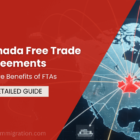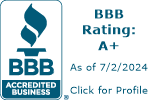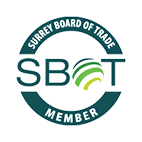“My company wants to send me to Toronto through an Intra-Company Transfer Visa, but I’m worried it won’t lead to permanent residence. Is the Intra-Company Transfer to PR pathway still worth it?”
That question came from Adarsh, a Senior Information Security Specialist based in Mumbai, during a recent strategy call. It’s a common concern among multinational company employees who are looking for permanent residency through the Intra-Company Transfer route.
The Intra-Company Transfer (ICT) program was once considered a reliable pathway to Canadian permanent residence. Today, it requires careful planning and strategy to successfully obtain PR through ICT route. Recent policy changes have made the process more complex.
In March 2025, Canada removed the CRS bonus points for job offers under Express Entry. It eliminated the key advantage for ICT workers depended on employer-supported job offer to boost their PR applications.
Over the years, I’ve supported executives, managers, and skilled professionals through every stage of the ICT journey, from securing work permits to achieving permanent residence.
This guide is based on real client experiences. It explains each step of the ICT-to-PR process, highlights key milestones, and shows how policy changes and personal choices can affect your path to permanent residence.
What is Intra-Company Transfer (ICT) in Canada?
Canada’s Intra-Company Transfer Visa Program is basically a pathway for multinational companies to move their key people from a foreign office to a Canadian branch, subsidiary, or affiliate.
It’s designed to support business continuity and knowledge transfer. Unlike most work permits, it’s LMIA-exempt and operates under regulation R205(a). It benefits both employers and employees:
ICT Benefits for Employers
ICT helps solve a big problem as they no longer have to wait months for LMIA processing. Instead, they can bring their key staff from their foreign branch to Canada quickly. This is especially useful during expansions, acquisitions, or when starting new operations.
ICT Benefits for Employees
The Intra-Company Transfer (ICT) provides a practical way to move to Canada without the delays and uncertainty associated with LMIA-based hiring. It allows skilled workers to continue working for their current employer under a closed work permit and gain experience for their permanent residency application.
However, your company must still demonstrate that transferring you provides a “significant benefit” to Canada. We’ll explore what that means in more detail later in the article.
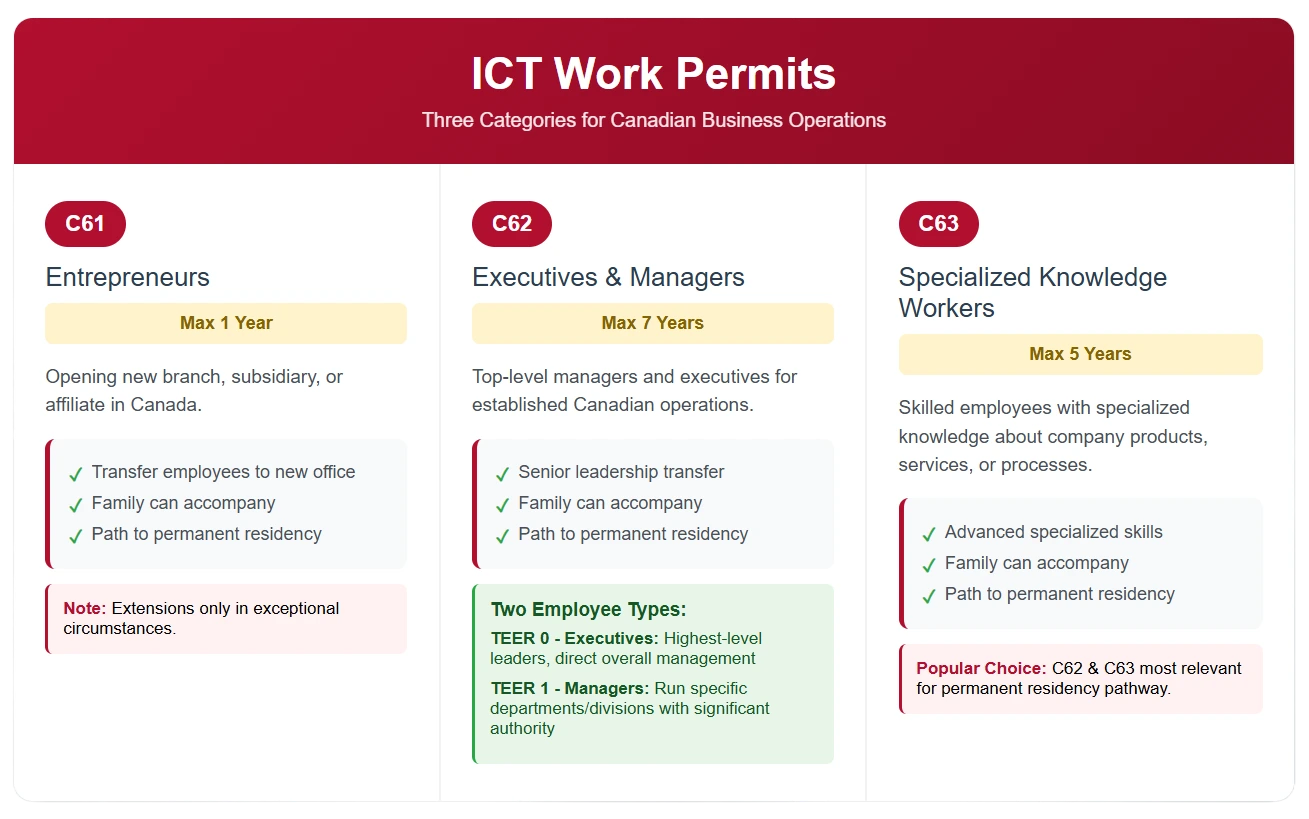
Intra-Company Transfer (ICT) Categories
Foreign nationals who want to work in Canada as intra-company transfers (ICT) must follow specific rules established under Canadian immigration regulations.
In 2024, IRCC replaced the old C12 exemption code with three new categories. Understanding which one applies to you is critical because each has different rules and limitations.
1. C61 – Start-Up Operations (Maximum 1 Year)
Code C61 is for people who want to expand their existing business by opening a new branch, subsidiary, or affiliate in Canada. It allows them to transfer employees from their foreign company to this new Canadian office. This option also allows the employee’s family to accompany them and can help establish a path toward permanent residency in Canada over time.
C61 ICT work permits are granted for an initial one-year period, and may only be extended in exceptional circumstances where delays in establishing the Canadian business were beyond the control of the applicant or employer.
2. C62 – Executives and Managers (Maximum 7 Years)
Code C62 is for foreign companies that want to send their top-level managers and executives to run their Canadian operations. It allows businesses to transfer their most experienced leaders from their home country to oversee important functions in Canada. This option also lets the employee’s family come with them and can help set the path toward permanent residency in Canada over time.
The Two Main Types of Employees under C62 Category are:
Executive Positions (TEER 0)
Not any executive, but those who are the highest-level leaders in an organization. Think of them as the people who shape the entire direction of a company or a major part of it. These executives must:
- Direct overall management
- Set goals and policies
- Make major decisions independently
- Report only to the very top level of the organization
Adarsh, the Senior Information Security Specialist mentioned earlier, oversees overall systems security for his Mumbai-based multinational technology company. In his executive role, he manages cloud services and cybersecurity across multiple offices and establishes strategic technology objectives.
He reports directly to the Chief Technology Officer and board of directors with no middle management supervising his work, which gives him the authority to determine how technology supports business operations. This is the kind of senior leadership role that qualifies for the executive category under Code C62.
Managerial Positions (TEER 1)
Managers operate one level below executives. They run specific parts of the business and have significant authority within their areas. The managers must:
- Manage specific areas: such as a department (like Human Resources), a division (like the Vancouver office), or a key function (like quality control)
- Supervise important people: like other managers, professional employees (like engineers or accountants), or essential business functions. They’re not just supervising entry-level workers.
- Make hiring decisions: They can recommend people for hiring, fire underperforming employees, promote deserving staff, or approve vacation requests. Even if they don’t make the final decision, their recommendations carry significant weight.
- Senior-level authority: Even if they don’t directly supervise people, they operate at a high level in the company hierarchy and make important decisions about their area of responsibility.
- Control daily operations: They decide how work gets done in their area, set priorities, allocate resources, and solve operational problems.
Ideal Example: A Marketing Manager who oversees all advertising campaigns and supervises marketing professionals.
3. C63 – Specialized Knowledge Workers (Maximum 5 Years)
Code C63 is for foreign companies that want to send their skilled employees to Canada. These employees have specialized knowledge about the company’s products, services, or processes.
These are people with advanced skills that are hard to find in their home country. They support important functions in Canadian operations. This option also allows the employee’s family to accompany them. It can help them work temporarily in Canada on ICT Work permits and eventually gain permanent residency.
Please Note: For the ease of this article, we’re focusing on C62 (executives and managers) and C63 (specialized knowledge workers) as these categories are most directly relevant for employees looking for a pathway to permanent residency in Canada.
Core Eligibility Requirements for Intra Company Transfer Visa in Canada
Before you can qualify for either the executive/managerial (C62) or specialized knowledge (C63) categories, you must meet several fundamental requirements. Think of these as the basic checklist that every applicant must satisfy, regardless of which specific category they’re applying under.
1. Employment Status
You must currently be working for a multinational corporation outside Canada in one of these roles:
- Executive position (for C62 applications)
- Managerial position (for C62 applications)
- Specialized knowledge role (for C63 applications)
You can’t apply if you’re unemployed, working for a local company that isn’t multinational, or in a role that doesn’t match these categories.
2. The Company Must Operate in Canada
Your foreign employer must have an active business presence in Canada, which means:
Already operating: The Canadian business is regularly, systematically, and continuously providing goods or services in Canada
Will be operating: If you’re helping establish a new operation, there must be a clear timeline and evidence showing when the Canadian business will begin operating
What doesn’t count as business operation:
- Just having an agent or representative office in Canada
- A company that exists only on paper with no actual employees or operations
- Businesses that aren’t actively engaged in real commercial activity
3. One Year of Continuous Employment
You must have worked full-time for your current employer for at least 1 year within the 3 years immediately before you apply. This means:
- Continuous employment: No significant gaps in your employment
- Same company: Your work experience must be with the same multinational corporation
- Similar capacity: Your role during this period should be similar to the position you’re applying for in Canada
- Recent experience: The 1-year requirement must be met within the past 3 years
4. Qualifying Corporate Relationship
The Canadian company you’re transferring to must have one of these relationships with your current employer:
- Parent company: The Canadian company owns your current employer
- Subsidiary: Your current employer owns the Canadian company
- Branch office: The Canadian operation is a branch of your current employer
- Affiliate: Both companies are owned by the same parent organization
5. Temporary Transfer with Return Position Available
This must be a temporary assignment where:
- Your position at your home country company remains available for you to return to
- You’re not permanently leaving your current employer
- The transfer has a defined duration and purpose
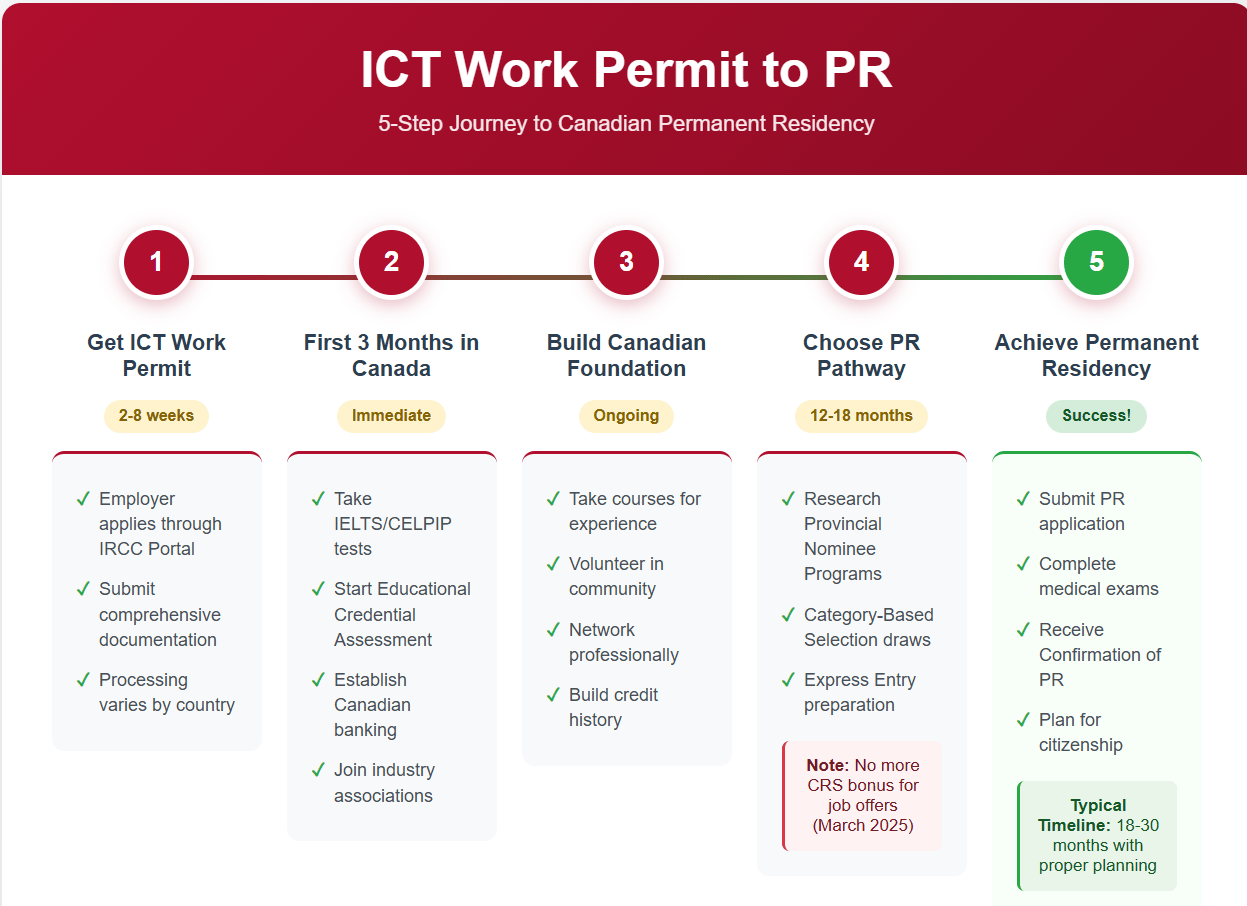
Step-by-Step Process: From ICT Work Permit to PR
So far, we have learned about the categories and eligibility criteria. Now, let’s go through the process you follow from an Intra-Company Transfer in Canada to permanent residency.
Stage 1: Securing Your ICT Work Permit
Your employer applies through the IRCC Employer Portal with comprehensive documentation. Processing typically takes 2-8 weeks for complete applications, but the timeframe can vary significantly based on the country of origin and the complexity of the application.
Stage 2: Building Your Canadian Foundation
Once you’re in Canada, the clock starts ticking on your permanent residence strategy. This is where most people make mistakes; they focus on work and forget about PR planning.
Here’s what successful ICT holders do during their work permit period: Immediate Actions (First 3 Months)
- Language improvement: Take IELTS/CELPIP tests even if you speak English well – formal scores matter more than fluency
- Educational credentials: Start your Educational Credential Assessment (ECA) process through WES or other recognized agencies
- Professional integration: Join industry associations and attend networking events
- Banking and credit: Establish Canadian banking relationships and start building credit history
Ongoing Strategy (Throughout Your ICT Period)
- Skill development: Take courses or certifications that enhance your Canadian work experience
- Community involvement: Volunteer or participate in local activities to demonstrate integration
- Provincial research: Study different Provincial Nominee Program options available to you
- Family planning: If applicable, ensure your spouse and children are also building Canadian connections
Stage 3: Navigating the Path to Permanent Residence
IRCC eliminated the 50 or 200 points CRS bonus for arranged employment as of March 25, 2025. This changed everything for ICT holders. Before this change, having a job offer gave you a massive advantage. Now, you need to compete based on other factors:
- Language proficiency (still the biggest point generator)
- Education credentials
- Age
- Canadian work experience
- Provincial nominations
Category-Based Selection Advantage
Healthcare, STEM, and other priority occupations get Category-Specific Express Entry draws with lower CRS cutoffs. If your ICT job occupation qualifies, you get invitation to apply for Canada PR even with a low CRS score.
Provincial Nominee Programs (PNP)
Many provinces actively recruit ICT holders already working in their jurisdiction. The logic is simple: you’re already contributing to their economy and have proven adaptability. I’ve had great success with clients using:
- Ontario Immigrant Nominee Program (OINP)
- British Columbia Provincial Nominee Program (BC PNP)
- Alberta Advantage Immigration Program (AAIP)
In my experience, the biggest barrier while obtaining a provincial nomination as an ICT employee is the lack of support from the respective employers. Most employers are unwilling to back their employees’ provincial nomination applications because once they receive permanent resident status in Canada, they are free to work for any employer.
This means that if they get PR status, they can move on to other job opportunities, which risks losing their employees.
Family Immigration Updates
New rules effective January 21, 2025, have tightened spousal work permit eligibility. Your spouse can get an open work permit if you’re in TEER 0 or 1 positions, with limited exceptions for some TEER 2-3 roles.
This affects immigration plans for the family significantly and could impact your overall PR strategy. Typical timeline for ICT holders: 18-30 months from arrival to PR with proper planning and execution.
Now let’s see how this played out in real life through Adarsh’s detailed experience.
Get Professional Help with Your Canadian PR Application
Apply for Canadian PR with the Help of Licensed RCIC Experts.
Real Success Story: Adarsh’s ICT to PR Timeline
Let’s continue the story of Adarsh. His multinational technology company wanted to transfer him to its Toronto office to oversee the expansion of its North American IT infrastructure. Like many ICT applicants, Adarsh had a bigger goal in mind. He wanted to use his work permit as a stepping stone to permanent residence for himself and his family.
Adarsh’s situation was complex:
- Senior IT Security Specialist with 8 years of experience in Mumbai
- Company expanding Canadian operations (18 months old)
- Specialized in proprietary cloud migration systems and cybersecurity protocols
- Married with one child, all hoping to build a permanent life in Canada
- Strong English skills but no formal Canadian credentials yet
Stage 1: Getting the ICT Work Permit
Adarsh’s company applied through the IRCC portal, and it took about 6 weeks to get approved. The key things that helped:
- Clear documentation showing the relationship between their Mumbai and Toronto offices
- Good explanation of why they needed him specifically in Canada
- Competitive salary offer
- Job description that showed real management responsibilities
His company was smart as they started preparing documents 3 months early, which made the whole process smoother.
Stage 2: First Year in Canada
Once Adarsh got to Canada in early 2024, he focused on setting himself up for permanent residence:
- Got his engineering degree assessed through WES before even applying for the work permit
- Took IELTS prep and scored well (CLB 9) within 6 months
- Started learning basic French
- Joined some professional IT groups and networking events
- Started researching PR options, especially the Ontario PNP
Stage 3: PR Application
The Canada PR process became complex in March 2025 when IRCC removed the job offer bonus points from Express Entry. Adarsh had to adjust his strategy:
- Focused on maximizing his language and education points
- His age (32) and Canadian work experience helped
- Received an invitation to apply under the STEM Category draw, based on eligibility through NOC Code 21220 — Cybersecurity Specialists
The category-based draws actually worked in his favour as lower cutoff scores for STEM occupations made it easier to get an invitation to apply.

Apply for Intra-Company Transfer Visa with Licensed Consultants
Speak with an expertELAAR’s Strategic Approach
- Pre-arrival preparation: Start the ECA process before coming to Canada to save valuable time
- Immediate language testing: Take IELTS even with strong English skills for maximum CRS points
- Professional integration strategy: Join specific industry associations and attend targeted networking events
- Family coordination: Ensure his wife also maximizes her Canadian work experience
- Strategic timing: Coordinated all applications for optimal processing times
- Policy adaptation: Adjusted strategy when immigration policies changed in 2025
- Risk mitigation: Prepared backup plans in case the primary strategy faced delays
FAQs: Intra-Company Transfer to PR Process
Can ICT guarantee permanent residence?
No, ICT is a work permit that creates pathways to PR. Success depends on building a strong profile through Canadian work experience, language skills, and meeting program requirements.
What’s the maximum time I can stay on ICT permits?
- Executives/Managers (C62): 7 years maximum
- Specialized Knowledge (C63): 5 years maximum
- Start-up Operations (C61): 1 year only, no extensions
Do I need a physical office in Canada?
Absolutely. IRCC has cracked down on virtual offices, requiring evidence of genuine business operations, a physical office space, local employees, business licenses, and active commercial activity.
How do recent Express Entry changes affect ICT holders?
The elimination of job offer bonus points means you can’t rely on arranged employment for CRS points. Focus on language improvement, education credentials, and provincial nominations instead.
Can my family get work and study rights?
Spouses of TEER 0-1 ICT holders can get open work permits under the new January 2025 rules. Children can study with appropriate permits. Processing times vary by country of origin.
Need Expert Help With Your ICT Application?
The ICT Work Permit to PR Pathway offers excellent opportunities for qualified professionals, but success requires strategic planning from the very beginning.
At ELAAR Immigration, we don’t just obtain your work permit; we create a personalized roadmap to Canadian permanent residence for you. It takes into account your specific situation, family considerations, and career goals.
Whether you’re an executive planning a major expansion, a manager leading new operations, or a specialized worker with unique expertise, we’ll help you navigate both the ICT process and permanent residency.
Our proven track record in ICT applications and PR transitions makes us the trusted partner for your Canadian immigration success.



